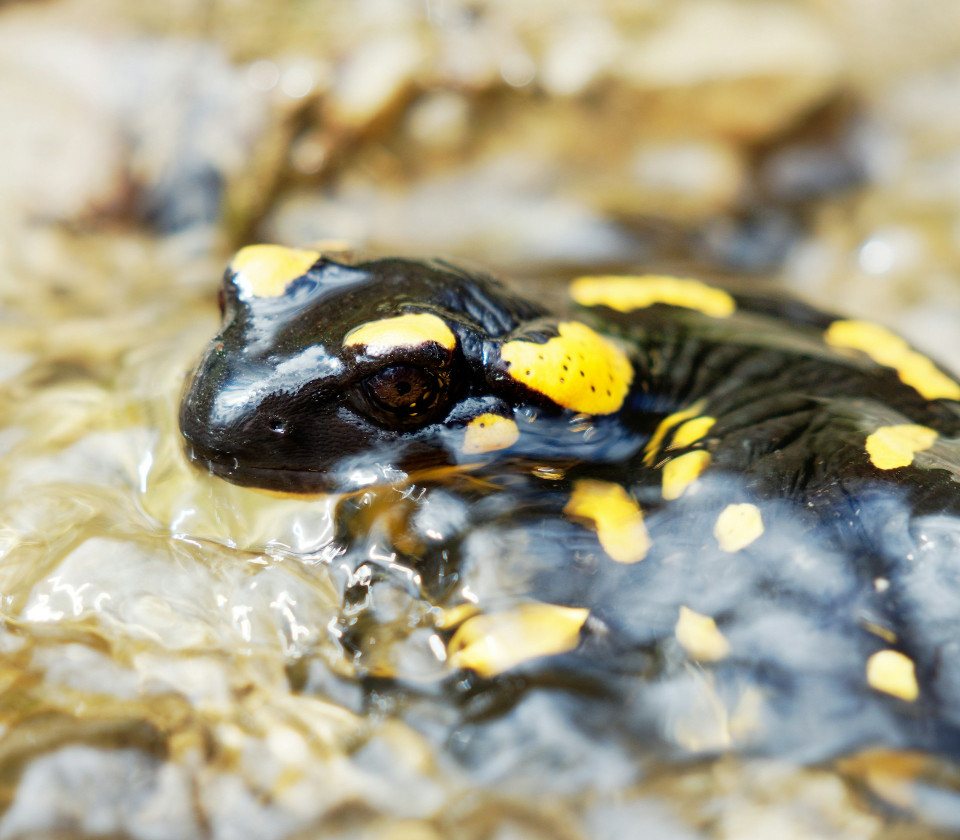Transfiguration of Our Lord
Mark 9:2-9
Six days later, Jesus took with him Peter and James and John, and led them up a high mountain apart, by themselves. And, he was transfigured before them, and his clothes became dazzling white, such as no one on earth could bleach them. And, there appeared to them Elijah with Moses, who were talking with Jesus. Then, Peter said to Jesus, “Rabbi, it is good for us to be here; let us make three dwellings, one for you, one for Moses, and one for Elijah.” He did not know what to say, for they were terrified. Then a cloud overshadowed them, and from the cloud there came a voice, “This is my Son, the Beloved; listen to him!” Suddenly when they looked around, they saw no one with them anymore, but only Jesus.
As they were coming down the mountain, he ordered them to tell no one about what they had seen, until after the Son of Man had risen from the dead.
Salamanders
Every once in a while, I get the urge to explore. I remember this sign that I would drive by every day as I went to work; it was for the Chumash Indian Museum, a place I had never gone to before. It was one of those things where you say, “Oh, I need to do that someday,” or “I need go there, someday,” but then you never actually do it?
One day, I decided that I had driven by this sign too many times, I mean, we’re talking years and years, three different jobs that all happened to be in the same general area, so my route to work was pretty much the same, and I kept driving past this sign. I needed to see what this Chumash Indian Museum was all about.
It was my day off, and I drove out there specifically to go to this museum. I pulled into an empty parking lot, not a good sign. And, as I walked up to the museum, it was obvious that it was closed. I probably should have check when it was open before making the drive out there. But, I was already there, so I decided to have a look around. I was able to see a little bit through the windows, it wasn’t a very big museum. They had some interesting displays outside, replicas of some of the buildings that the Chumash people would have made. And, there was a little nature trail that wandered off into the wilderness behind, so I decided to keep exploring.
The trail seemed to follow a dry creek, going through a pretty heavily forested area, lots of flowers and mushrooms, big rocky outcrops and boulders. It eventually led to a short craggy rock wall, maybe about fifteen or twenty feet high. I guessed that when there was water in the creek, it would flow over this rock wall, creating a waterfall. The trail seemed to peter out at this point, but the wall looked pretty easy to climb, and I wondered if I could get to the top and see what was up there.
Like I said, it was really craggy, so lots of rocky shelves to stand on, lots of footholds and handholds, I mean, it was pretty easy, and I wasn’t in any danger of falling. About halfway up, I found these pools of water that had been trapped there from the last time water flowed down the wall. They were small, maybe a foot across, or even less, and I think I remember there three or four of them. You could tell from how they were positioned that when the creek was running, the water would flow from one pool to the next, and so on, until it reached the creek bed below. Even though the pools were small, they were pretty deep, and in the shade of the rock wall, there wasn’t any sunlight going into them, so they kind of looked like these little bottomless wells. As I looked into the water, I noticed that there was something floating in it. There were these flashes of yellow and orange and red, and I realized there were salamanders in the water, or maybe newts, I’ve tried to figure what species they were, but I’ve never been able to.
From my vantage point, they looked like they had black bodies, with these splotches of yellow or red on their bellies, there were dozens of them, maybe about five inches long. As I watched, they would swim up to the surface, never coming above the water, and then they would sink back down; as if they were being pushing along in this slow circular current, like a tiny underwater ballet. It was one of those moments when you know you’re witnessing something really special and magical, and you don’t know if you’re ever going to see something like that again, so you just need to take in as much of it as possible. So, I sat there, mesmerized by these little salamanders floating up and down in their little pools, halfway up a rock wall, and I knew that God had brought me there so that I could see this little hidden world. It helped to remind me that God is everywhere, that we are intimately connected to our world, and that the creatures of this world depend on us to take care of them.
God’s presence is always transformative. Peter, James, and John had no idea what they were going to see when they went up that mountain that day with Jesus. They were living in the time of miracles; they had seen Jesus heal people with a touch, drive out demons, turn water into wine, but this was something different. This was something new.
Jesus was transformed right in front of their eyes; his clothes became white. In the other versions of this story in the gospels of Matthew and Luke, his face changes and shines like the sun. Two other men appeared before them, heroes from their ancestral stories, Elijah and Moses. The text doesn’t tell us that they were introduced to Peter, James, and John, as Elijah and Moses, it makes it seem like they just somehow knew. And, Peter, being Peter, says the first thing that comes to mind, and offered to build three houses up there on the mountain, one for Jesus, one for Elijah, and one for Moses.
But, before Jesus can say anything, a voice comes down from the heavens, “This is my Son, the Beloved; listen to him!” And then, they come down from the mountain, and Jesus tells them not to share what happened with anyone, until he has been raised from the dead, which, of course, they did not understand.
Transfiguration Sunday comes between Epiphany and Lent, a time of transition and change. It comes at the beginning of each new year, as we begin to look forward to warm days and the greening of the trees. As much as some of us might not like it, change is an inevitable part of life. As I look back on my own life, it is always the times of transition and change that stand out for me: my decision to go back to school after being out of school for seven years, opening a bakery and then leaving it, moving away from home for the first time to go to seminary, becoming a live-in caregiver, and then my accident that landed me in the hospital before moving from California to Montana.
All of these transitions, all of these changes, they’re a part of who I am. All of them are important, even the ones that hurt me. They are what made me who I am today.
I went back to that rock wall, because I wanted to see the salamanders again; I think it was a year later, give or take. When I climbed up the rock wall, the little pools were empty and dry, so no salamanders. I knew it was a long shot; I had probably stumbled onto some kind of seasonal event, or maybe even some random occurrence. I knew when I was seeing it that I might never see it again. But, God had already shown me what I needed to see; I had already been changed, and the world had already been made more mysterious and wonderful. I had been reminded of God’s presence all around me. I guess seeing it again would have been gilding the lily.
As we leave Epiphany and move into Lent, I invite you to think about the transitions in your life, and ask yourself how God was present in that time of change. Are there any changes on the horizon that you might have been worrying about? God is always present during these times, because times of change are important. God will help you get through the changes in your life, and help you to learn what you need to learn from those changes. God’s presence is always transformative. So, open yourself to the mystery and the wonder of God, and let yourself be transformed. Amen.
~ Rev. Charles Wei




